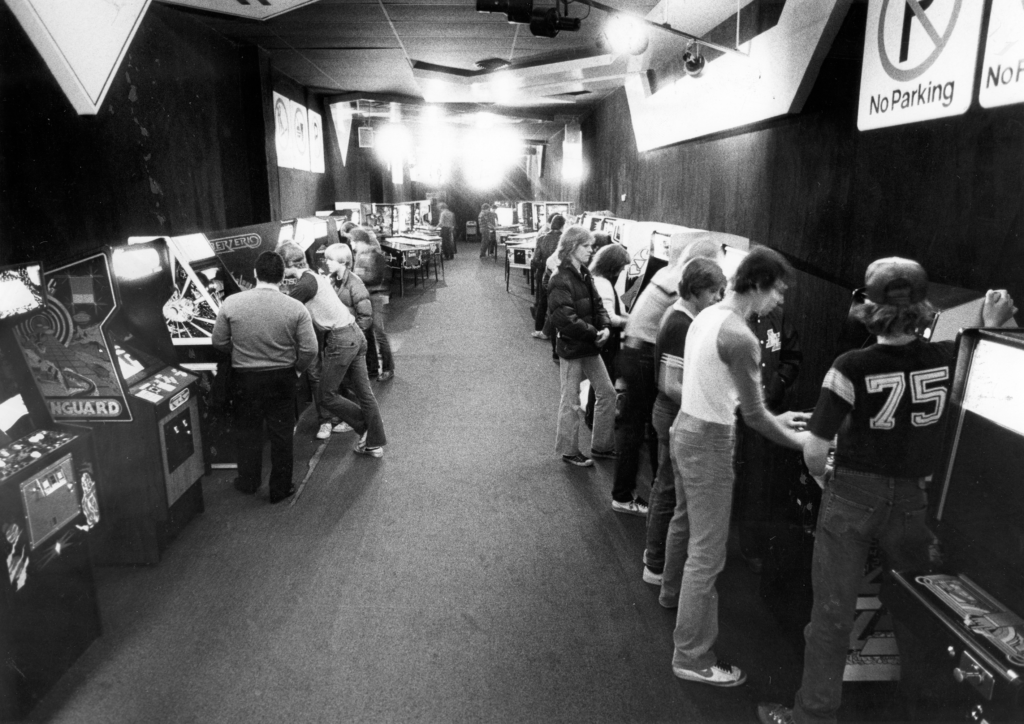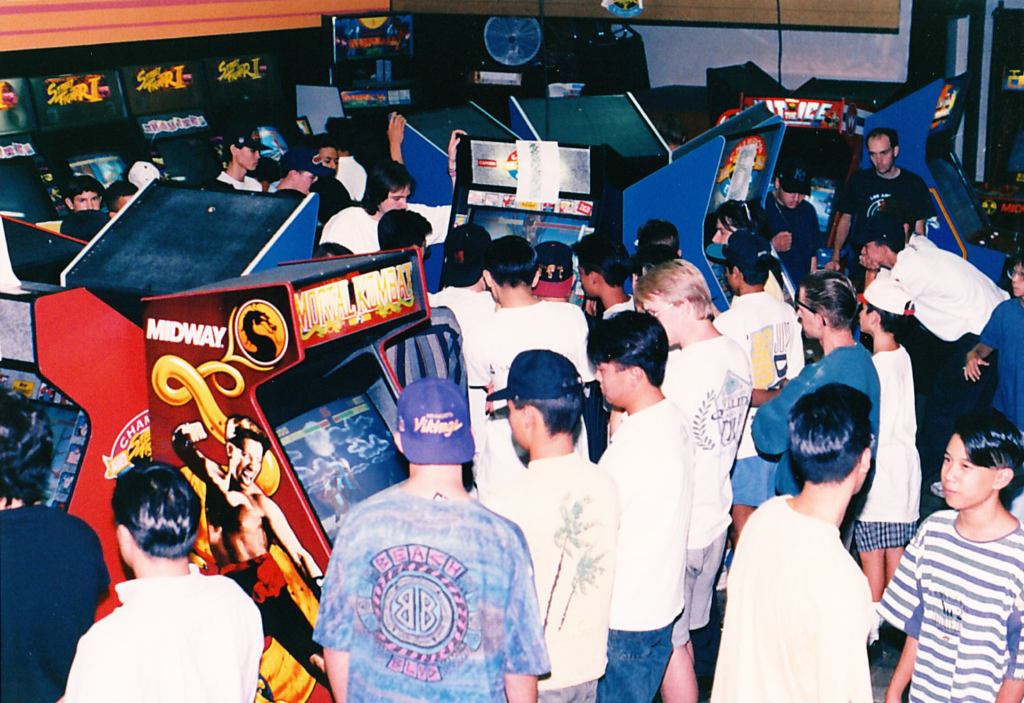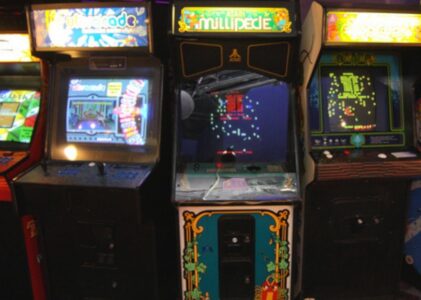Arcades, those dimly lit temples of flashing lights and pixelated dreams, hold a special place in the hearts of many. For those who grew up in the ’70s, ’80s, and ’90s, the mention of arcades conjures memories of a bygone era when a pocketful of quarters meant hours of thrilling gaming adventures. Arcade mania was more than just a craze; it was a cultural phenomenon that swept the globe, igniting a passion for gaming that endures to this day.
The Birth of Arcades
The origins of arcades can be traced back to the late 19th century when the first coin-operated machines made their appearance. These early contraptions, often found in bars and amusement parks, were simple novelties that provided a brief diversion. However, it wasn’t until the 1970s that the concept of arcades as we know them today began to take shape.

The Birth of the Video Game Arcade
In 1971, a young engineer named Nolan Bushnell founded Atari and released the groundbreaking arcade game, “Pong.” Pong was a table tennis simulation that became an instant hit, captivating players with its addictive gameplay. This success marked the birth of the video game arcade.
With the advent of microprocessors and the development of more sophisticated hardware, video games began to evolve rapidly. The pixelated black-and-white graphics of Pong gave way to vibrant color displays and increasingly complex gameplay. Arcades popped up in malls, movie theaters, and street corners, becoming a gathering place for gamers of all ages.
The Golden Age of Arcades
The late ’70s and early ’80s are often referred to as the “Golden Age” of arcades. This was a time when a wave of innovative and iconic games flooded the market, captivating players and solidifying the arcade’s place in popular culture.
Pac-Man: The Maze-Chomping Sensation
In 1980, Namco introduced a game that would become a cultural phenomenon: “Pac-Man.” This iconic yellow circle with a voracious appetite for dots and ghosts became an overnight sensation. The game’s simplicity, combined with its challenging mazes and catchy music, made it a smash hit. “Pac-Man Fever” swept the nation, inspiring merchandise, music, and even an animated TV series.
Donkey Kong: The Rise of Jumpman
Around the same time, a little-known company called Nintendo released “Donkey Kong.” This game introduced players to a character who would later become one of the most recognizable in the world of gaming: Mario. Donkey Kong marked the debut of Mario (initially known as Jumpman) and introduced the concept of platform gaming. The game’s mix of action and strategy resonated with players, contributing to the arcade’s enduring appeal.
Space Invaders: Alien Invasion
In 1978, Taito unleashed “Space Invaders” upon the world. This game challenged players to defend Earth from a relentless horde of descending alien invaders. The simple yet intense gameplay and iconic alien design made “Space Invaders” a massive hit, establishing it as a classic of the era.

Centipede and Galaga: Shaping the Shooter Genre
Atari’s “Centipede” (1980) and Namco’s “Galaga” (1981) are two more titles that left an indelible mark on the arcade landscape. “Centipede” introduced players to the world of trackball-controlled shooters, while “Galaga” refined the shoot ’em up genre with its challenging waves of alien enemies. These games pushed the boundaries of what was possible in terms of gameplay and graphics.
The Impact of Arcade Mania
Arcade mania was not just about playing games; it was a cultural phenomenon that influenced music, fashion, and entertainment. Let’s explore how the arcade craze shaped various aspects of popular culture.
The Birth of Competitive Gaming
One of the most significant impacts of the arcade era was the emergence of competitive gaming. Players would gather around cabinets, engaging in head-to-head battles or competing for high scores. Arcade tournaments became common, and skilled players gained celebrity status. This competitive spirit laid the groundwork for the eSports industry we know today.
The Soundtrack of the Arcade
The memorable music and sound effects of arcade games became an integral part of their charm. Composers like Nobuo Uematsu (known for his work on “Final Fantasy”) and Yoko Shimomura (composer of “Street Fighter II”) crafted iconic tunes that still resonate with gamers today. These melodies transcended the arcade, finding their way into pop culture and becoming a source of nostalgia for an entire generation.
The Rise of Arcade Fashion
The aesthetics of arcade games also influenced fashion trends. The vibrant colors, pixel art, and futuristic themes of games like “Tron” and “Asteroids” inspired clothing designers. Neon colors, geometric patterns, and references to arcade culture became popular in clothing lines and streetwear.
Arcade Icons in Pop Culture
Arcade characters like Pac-Man, Mario, and Sonic the Hedgehog became cultural icons. They appeared in cartoons, merchandise, and even Hollywood movies. The enduring appeal of these characters and their universes helped solidify the legacy of arcade mania.
The Evolution of Arcade Games
As technology advanced, so did arcade games. The ’90s brought a new wave of innovation and creativity to the arcade scene.
Fighting Games: Mortal Kombat and Street Fighter
The fighting game genre exploded with titles like “Mortal Kombat” and “Street Fighter II.” These games introduced complex combos, special moves, and memorable characters. They also sparked debates about violence in video games due to their graphic content.
Racing Games: The Thrill of the Track
Games like “Out Run” and “Daytona USA” revolutionized the racing genre, offering players the chance to experience high-speed thrills from the comfort of an arcade cabinet. The realistic graphics and immersive gameplay made these games stand out.

Dance Dance Revolution: A Physical Challenge
Konami’s “Dance Dance Revolution” (DDR) brought a unique physical element to arcades. Players had to step on floor panels in sync with on-screen cues, combining gaming with exercise. DDR became a hit not only in arcades but also in fitness centers and homes.
The Decline of Arcades
Despite their cultural impact, arcade mania began to wane in the late ’90s and early 2000s. Several factors contributed to the decline of arcades.
The Rise of Home Consoles
The advent of home gaming consoles like the Atari 2600, Nintendo Entertainment System (NES), and Sega Genesis allowed players to enjoy arcade-like experiences from the comfort of their living rooms. With improved graphics and gameplay, home consoles offered convenience and cost savings that arcades couldn’t match.
The Internet and Online Gaming
The rise of the internet brought multiplayer gaming into homes. Gamers could now connect with friends and rivals worldwide, eliminating the need for physical arcade gatherings. Online multiplayer games and digital distribution platforms further reduced the appeal of arcades.
Changing Demographics
As the generations that grew up with arcades aged, the demographics of gamers shifted. Arcade operators struggled to attract new audiences and compete with other forms of entertainment.
A Resurgence of Arcade Culture
While arcades may have lost their dominance, they never truly disappeared. In recent years, there has been a resurgence of interest in arcade culture, driven by nostalgia and a desire for unique gaming experiences.
Barcades: Combining Drinks and Games
The concept of “barcades” has gained popularity, blending the social atmosphere of a bar with classic arcade games. These venues offer patrons the chance to enjoy a cold beverage while playing their favorite games from the past.
Retro Arcade Cabinets
Companies like Arcade1Up produce home arcade cabinets that recreate the look and feel of classic arcades. These cabinets come with pre-loaded games, allowing gamers to relive the nostalgia of their youth.
VR and Modern Arcades
Virtual reality (VR) has breathed new life into arcades. VR arcades provide immersive experiences that cannot be replicated at home. Players can don VR headsets and step into fantastical worlds, making this a unique evolution of the arcade concept.
Conclusion
Arcade mania was more than a fleeting fad; it was a cultural phenomenon that left an indelible mark on society. From the early days of “Pong” to the resurgence of arcades in the 21st century, the arcade experience has continued to captivate generations of gamers. The games and memories of arcade mania will forever hold a special place in the hearts of those who experienced this golden age of gaming.

